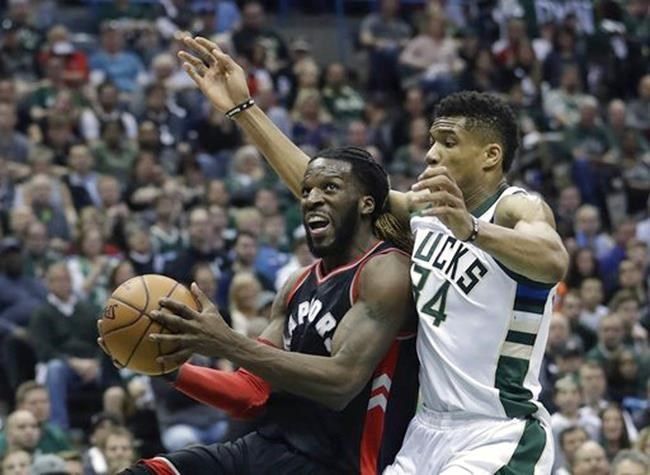
In this April 22, 2017, file photo, Toronto Raptors' DeMarre Carroll, left, drives past Milwaukee Bucks' Giannis Antetokounmpo during the first half of Game 4 of an NBA first-round playoff series basketball game in Milwaukee. THE CANADIAN PRESS/AP/Morry Gash, File
April 04, 2019 - 8:08 AM
Watching the NBA playoffs, Alexander Hinton had the same frustration a lot of fans do: the coach of his favourite team was keeping big-name players on the floor and unheralded bench players with a hot hand weren't getting a chance.
Fortunately, Hinton was in a position to prove his hunch.
Hinton and Prof. Yiguo Sun from the University of Guelph have published a research paper in the journal Empirical Economics that found that professional basketball players being paid high salaries tend to get slightly more playing time than their on-court performance suggests they deserve.
"I was just frustrated with some of the playing-time decisions I was seeing," said Hinton, who was a masters student in economics at the time. "So, specifically, I was wondering if a sunk cost was being taken into account for the player's playing time."
The sunk-cost fallacy is an economic concept where the use of a resource is justified because time or money have already been invested in it. For example, many people would feel obligated to attend a concert they had already purchased a ticket to despite not really wanting to go. Their logic is that to skip the show, it would be a waste of the money already spent.
In Hinton and Sun's study, they found that, on average, higher-paid NBA players got 42 to 48 seconds more court time per game than players earning less than half their salary who were equally good statistically.
Someone earning US$27 million playing alongside a comparable player earning $10 million got almost a minute more court time per game.
"Intuitively, you would think the amount of time a player spends on court would solely depend on how well they perform," said Sun. "But it doesn't work that way in practice. We found that salary does have a positive impact on how long they play."
They analyzed 465 NBA athletes between the 2013-14 and 2016-17 seasons, looking at key markers such as free-throw percentages, points-per-minute and blocks-per-minute, as well as age and experience.
Their study also accounted for "unobservable player characteristics," such as a player’s popularity or leadership, which can also affect playing time, as well as periods when players perform better alongside certain teammates.
Fans of the Toronto Raptors might not be surprised about who some of the best examples of the sunk-cost fallacy in the NBA were during the study period.
"Some of the names that came within the top few examples were Andrea Bargnani and DeMarre Carroll," said Hinton. "They were classic examples of a player who came in on a big contract and the team made a deal about it."
Bargnani averaged 15.2 points, 4.8 rebounds, and 1.3 assists over 30.3 minutes per game in his seven seasons with the Raptors. He earned more than $46.8 million in that time, including $10 million his final season.
Carroll averaged 9.4 points, 4.1 rebounds, and one assist over 27.2 minutes per game in his two seasons in Toronto. He earned $27.8 million in that time.
___
Follow @jchidleyhill on Twitter
News from © The Canadian Press, 2019